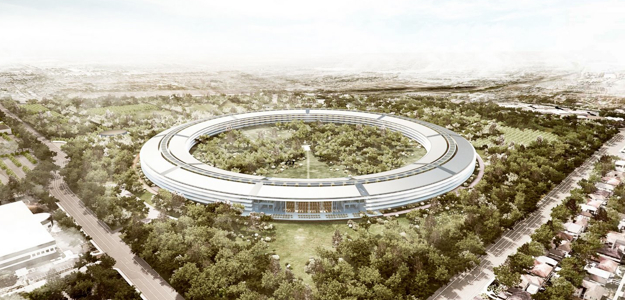 Before his death in 2011, Steve Jobs described the future corporate campus for Apple – which, at that time, was in the planning stages and requiring permissions from Cupertino City Council – as both “the best office building in the world” and “a little like a spaceship.” Two years on, that last line is beginning to seem particularly appropriate as the costs of constructing the new campus are heading into the stratosphere, with new projections shooting upward of $5 billion.
Before his death in 2011, Steve Jobs described the future corporate campus for Apple – which, at that time, was in the planning stages and requiring permissions from Cupertino City Council – as both “the best office building in the world” and “a little like a spaceship.” Two years on, that last line is beginning to seem particularly appropriate as the costs of constructing the new campus are heading into the stratosphere, with new projections shooting upward of $5 billion.
The new figure is significantly higher than the less than $3 billion estimate originally given for the project, which will see the addition of more than 6,000 trees to the area to hide roads and traffic from view. The project will also create a massive, 40-foot tall floor-to-ceiling concave glass panels for a building that is expected to house more than 12,000 employees at any one time.
The concave glass panels were a selling feature, according to Jobs. During his presentation to the Cupertino Council for planning permission, he admitted that “there isn’t a straight piece of glass on the whole building.” The panels are meant to harken back to the groundbreaking “invisible” glass stairs of multiple Apple stores around the world, and are to be manufactured by the same company, Seele. Unfortunately, in order to manufacture panels at the necessary size, Seele will have to do so in a plant in Germany, and air-ship them to the U.S. – just one reason why the costs for this project have risen so dramatically from earlier estimates.
The start date for the construction project has been delayed from its original 2012 date to later this year. Apple plans to start demolishing existing buildings on the site this June, according to reports, in part because the company has been working with architects to cut costs as much as possible. A report in Bloomberg Businessweek, citing anonymous sources close to the project, suggests that Apple is looking to cut as much as $1 billion from the project before construction begins, and has been working with Foster + Partners – the lead architecture firm on the job, known for the Hearst Tower in New York – to make this happen.
One of the difficulties in finding ways to reduce the budget for the project without compromising Jobs’ vision for the campus. Following his death, staying true to what Jobs wanted from projects at the company took on a new importance that was difficult to move away without seeming disrespectful to his memory. However, such changes will have to be made by those responsible for the new headquarters. Otherwise, Apple’s new headquarters will have the dubious honor of being known as the corporate HQ that cost more to build than the World Trade Center rebuilding project.
Editors' Recommendations
- DJI’s new gimbal, Apple’s AR content, and more | Digital Trends Live
- Digital Trends Live: Intel’s new laptop concept, Apple foldable device, and more


